2023-03-23 - Nº 412
Editorial
Esta é a Newsletter Nº 412 que se apresenta com o mesmo formato que as anteriores. Se gostar da Newsletter partilhe-a!
Todas as Newsletters encontram-se indexadas no link.
Esta Newsletter tem os seguintes tópicos:
Faz hoje anos que nascia, em 1749, o matemático, físico e astrónomo francês Pierre-Simon Laplace. Ele ficou conhecido pela sua análise matemática da estabilidade do sistema solar (1773), aliviando as preocupações de Isaac Newton sobre as perturbações entre planetas. Ele fez uma abordagem exacta da ciência. Ele desenvolveu uma explicação da tensão superficial de um líquido em termos de atracções intermoleculares, investigou a acção capilar e a velocidade do som. Ajudou Antoine Lavoisier (1783) a investigar o calor específico e os aquecedores de combustão, iniciando a ciência da termoquímica. Ele acreditava que o sistema solar se formou a partir de uma nebulosa em colapso. Contribuiu para a matemática da probabilidade e cálculo, na qual uma equação diferencial é conhecida pelo seu nome, e esteve envolvido no estabelecimento do sistema métrico.
Faz também hoje anos que nascia, em 1881, o químico alemão Hermann Staudinger. Ele recebeu o Prémio Nobel da Química de 1953 pela sua descoberta da estrutura dos polímeros como moléculas de cadeia longa. Em 1910, desenvolveu uma nova e simples síntese para o isopreno, a unidade molecular básica em borracha sintética. Na década de 1920, Staudinger tinha formado a sua opinião de que as moléculas de polímero podiam ser uma cadeia muito longa de unidades repetidas unidas por ligações químicas normais, em vez da opinião predominante de que os polímeros eram apenas uma agregação desordenada de moléculas mais pequenas mantidas juntas por algumas outras forças. Ele cunhou o termo macromolécula (1922). Eventualmente, a cristalografia de raios X confirmou a sua estrutura de polímeros de cadeia longa. O seu trabalho foi uma grande contribuição para a biologia molecular.
Faz igualmente hoje anos que nascia, em 1882, a matemática alemã Emmy Noether. Ela ficou conhecida pelas suas contribuições para a álgebra abstracta, em particular, o seu estudo das condições de cadeia sobre ideais de anéis. Na física teórica, produziu o Teorema de Noether, que prova uma relação entre simetrias na física e princípios de conservação. Este resultado básico na teoria geral da relatividade foi elogiado por Einstein. Foi o seu trabalho na teoria das invariantes que levou à formulação de vários conceitos da teoria geral da relatividade de Einstein. Para o seu obituário no The New York Times, Albert Einstein escreveu: "Fraulein Noether foi o génio matemático mais significativo produzido até agora desde o início do ensino superior das mulheres".
Faz também hoje anos que nascia, em 1905, o físico inglês John Randall. Ele contribuiu com melhorias críticas ao magnetrão da cavidade, o dispositivo gerador de microondas utilizado no radar, foi uma importante descoberta para vencer a Segunda Guerra Mundial. Um magnetrão é agora comum nas casas dentro do forno de microondas. Os magnetrões anteriores fabricados na década de 1920 deram uma baixa potência. Em Fevereiro de 1940, o desenvolvimento por Randall com Harry Boot do pequeno magnetrão de cavidade que gerava comprimentos de onda de centímetros a uma potência muito superior, permitiu que o radar detectasse objectos mais pequenos. Por sua vez, este equipamento mais compacto com uma antena mais pequena permitiu a fácil instalação móvel de radar de alta resolução em aeronaves. Após a guerra, Randall virou-se para a biofísica, incluindo a realização de trabalhos experimentais sobre a estrutura do ADN.
Por fim, faz hoje anos que nascia, em 1912, o engenheiro de foguetes germano-americano Wernher von Braun. Ele foi um dos mais importantes criadores de foguetes e da sua evolução para aplicações na exploração espacial. O seu interesse começou quando era adolescente na Alemanha, e durante a II Guerra Mundial liderou o desenvolvimento do míssil balístico mortal V-2 para os nazis (cujo papel permanece controverso). Após a guerra, foi levado a usar os seus conhecimentos para produzir foguetes para o exército dos EUA. Em 1960, transferiu-se para a recém-formada NASA e tornou-se director do Marshall Space Flight Center e arquitecto chefe do veículo de lançamento Saturn V utilizado para colocar homens na lua. As suas contribuições incluem os satélites Explorer; Júpiter, Pershing, Redstone e Saturn foguetes, e Skylab.
Em 1875, a primeira sondagem da Fossa das Marianas foi feita pelo navio de pesquisa britânico, H.M.S. Challenger, durante a sua primeira expedição oceanográfica global, descobrindo parte da região mais profunda conhecida dos oceanos da Terra. As medições precisas da superfície continuam a ser difíceis, mas em 2010, a NOAA utilizou impulsos sonoros para gravar uma profundidade de 36.070 pés (10.994 m) na fossa Challenger Deep no seu extremo sul. A Fossa das Marianas situa-se no Oceano Pacífico ocidental, a leste das Ilhas Marianas, perto de Guam. A sua grande profundidade resulta na colisão de duas enormes placas de crosta oceânica, uma zona de subducção, onde a borda de uma mergulha por baixo da outra no manto da Terra. A 23 de Janeiro de 1960, Piccard e Walsh atingiram o fundo na baia de Trieste.
Em 2001, a estação espacial russa, Mir, terminou 15 anos em órbita ao arder na atmosfera terrestre como o caminho escolhido para terminar a sua vida. Mir, lançada em 1986, tinha ultrapassado largamente a sua duração original de cinco anos prevista. O governo russo decidiu em Outubro de 2000 que o seu mau estado já não podia justificar as despesas para manter a sua utilização. Um navio-tanque Progress atracado tinha sido comandado remotamente por controladores de missão para disparar foguetes e baixar a sua órbita e provocar a sua reentrada na atmosfera. Os destroços que não arderam durante a reentrada caíram inofensivamente no Oceano Pacífico, na zona alvo planeada entre a Nova Zelândia e o Chile. Por razões de segurança, as companhias aéreas tinham reencaminhado os voos do Pacífico em antecipação do evento, e os navios tinham sido avisados mais cedo.
Na Newsletter desta semana apresentamos diversas noticias, artigos científicos, projetos de maker e alguns vídeos interessantes.
 João Alves ([email protected])
João Alves ([email protected])
O conteúdo da Newsletter encontra-se sob a licença  Creative Commons Attribution-NonCommercial-ShareAlike 4.0 International License.
Creative Commons Attribution-NonCommercial-ShareAlike 4.0 International License.
Novidades da Semana
Outras Notícias

NASA’s Webb Spots Swirling, Gritty Clouds on Remote Planet
"In just a few hours of observations, the space telescope revealed a dynamic atmosphere on a planet 40 light-years from Earth. Researchers observing with NASA’s James Webb Space Telescope have pinpointed silicate cloud features in a distant planet’s atmosphere. The atmosphere is constantly rising, mixing, and moving during its 22-hour day, bringing hotter material up and pushing colder material down. The resulting brightness changes are so dramatic that it is the most variable planetary-mass object known to date. The team, led by Brittany Miles of the University of Arizona, also made extraordinarily clear detections of water, methane, and carbon monoxide with Webb’s data, and found evidence of carbon dioxide. This is the largest number of molecules ever identified all at once on a planet outside our solar system." [...]

Nexperia introduces the first application-specific MOSFETs (ASFETs) for hotswap in SMD copper-clip LFPAK88 packaging for 60% reduced footprint
"Additional 40% lower RDS(on) and increase power density by 58x for telecom & computing hot-swap computing applications Nexperia, the expert in essential semiconductors, today announced the release of its first 80 V and 100 V application-specific MOSFETs (ASFETs) for hotswap with enhanced safe operating area (SOA) in a compact 8x8 mm LFPAK88 package. These new ASFETs are fully optimized for demanding hotswap and soft-start applications and are qualified to 175°C for use in advanced telecom and computing equipment. By applying decades of expertise in both advanced silicon and package development, Nexperia’s PSMN2R3-100SSE (100 V, 2.3 mΩ N-channel ASFET) is the leading addition in the portfolio, delivering low RDS(on) and strong linear-mode (safe operating area) performance in a compact 8x8 mm footprint, tailored to meet the requirements of demanding hotswap applications. Nexperia has also released PSMN1R9-100SSE (80 V, 1.9 mΩ), an 80 V ASFET which responds to the growing trend for using 48 V power rails in computing servers and other industrial applications where environmental conditions allow for MOSFETs with a lower BVDS rating. ASFETs with enhanced SOA are becoming increasingly popular within hotswap and soft start applications. Their strong linear mode performance is essential to manage in-rush current effectively and reliably when capacitive loads are introduced to the live backplane." [...]

T-Systems to Offer Quantum Computing Expertise and Access to IBM Quantum Computational Resources
"T-Systems offerings range from one-day introductory sessions to business-case proofs-of-concept over several months As part of the IBM Quantum Network, T-Systems to provide customers with cloud access to IBM quantum computers T-Systems will now have the ability to provide its customers with cloud access to IBM’s quantum systems, including multiple quantum computers powered by the 127-qubit IBM Eagle processor. Quantum computing aims to enable calculations that are beyond the means of even the world’s most advanced classical supercomputers. This announcement sees the Deutsche Telekom IT subsidiary embark on the path to providing access to this technology, as well as insights on how it can be applicable to its customers’ businesses. In addition, T-Systems will offer dedicated quantum know-how and training. Customers will have access to T-Systems quantum services tailored to their needs, in a set of different customizable packages. These range from one-day introductory sessions, through to business case proofs-of-concept over several months." [...]
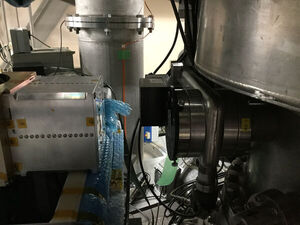
Unique quantum inference effect captured by cosmic X-ray polarimeter - New physics experiments opened up by a state-of-the-art space observation instrument
"An unanticipated polarization of high-energy X-rays emitted when highly charged ions capture high-energy electrons has been discovered experimentally for the first time. The measurement used a high-energy X-ray polarization detector that has been previously developed for high sensitivity space observations with the electron beam ion trap Tokyo-EBIT experiment at the University of Electro-Communications. Estimates from atomic physics had previously suggested that the electron state transition would emit unpolarized radiation, but the measured X-rays turned out to be highly polarized. Polarization measurements of high-energy X-rays are considered valuable in atomic physics research, but their use has been hindered in the past due to the lack of detectors capable of accurate measurements. These experiments were performed by Associate Professor Watanabe Shin (JAXA Institute of Space and Astronautical Science, ISAS) who joined the experimental group led by Professor Nakamura Nobuyuki (Institute for Laser Science, University of Electro-Communications) and Professor Takahashi Tadayuki (Kavli IPMU, University of Tokyo). These results were achieved by combining two state-of-the-art instruments and technologies: the EBIT-CC high-energy Compton X-ray polarimeter developed for space observations and adapted for this research principally at the JAXA Institute of Space and Astronautical Science (ISAS), and the Tokyo-EBIT world-leading multiply-charge ion generator and experimental instrument at the University of Electro-Communications." [...]

New MPLAB® SiC Power Simulator Allows Customers to Test Microchip’s SiC Power Solutions in Design Phase
"Microchip’s PLECS-based tool quickly evaluates solutions across power-switching topologies before committing design to hardware The electrification of everything is driving the growth of SiC semiconductors as large market segments such as E-Mobility, sustainability and industrial turn to SiC power solutions because of its fast-switching capabilities, lower power loss and higher temperature performance. To help power design engineers transition to SiC power solutions with ease, speed and confidence, Microchip Technology (Nasdaq: MCHP) today announces its MPLAB® SiC Power Simulator that quickly evaluates Microchip’s SiC power devices and modules across various topologies before committing a design to hardware. Microchip’s MPLAB SiC Power Simulator is a PLECS-based software environment designed in collaboration with Plexim to provide an online complimentary tool that eliminates the need to purchase a simulation license. The MPLAB SiC Power Simulator accelerates the design process of various SiC-based power topologies. Customers can confidently benchmark and evaluate SiC solutions in the design phase. “Customers who are pursuing SiC technology can now use the web-based MPLAB SiC Power Simulator to benchmark and select the best Microchip SiC product for their design,” said Clayton Pillion, vice president of Microchip’s silicon carbide business unit." [...]

First AI-enhanced smart accelerometers from STMicroelectronics raise performance and efficiency for always-aware applications
"STMicroelectronics has launched three new accelerometers with advanced processing engines built-in to extend sensor autonomy, enabling systems to respond more quickly to external events while lowering power consumption. The LIS2DUX12 and LIS2DUXS12 leverage ST’s third-generation MEMS technology, adding programmable capabilities including machine-learning core (MLC), advanced finite state machine (FSM), and an enhanced pedometer. A third entry-level accelerometer, LIS2DU12, is also available for less demanding applications. All three products are equipped with the latest industry standard I3C interface. The three devices integrate the common digital features for detecting events, as well as an anti-aliasing filter for high accuracy at lower sampling frequencies with performance benefits for accurate gesture detection at negligible power consumption. The integrated MLC in the LIS2DUX12 and LIS2DUXS12 enables artificial-intelligence (AI) algorithms to perform reliable activity detection and the FSM enhances movement recognition." [...]

onsemi Develops IGBT FS7 Switch Platform with Leading Performance for Industrial Markets
"New 1200 V devices offer the best conduction and switching performance on the market onsemi, a leader in intelligent power and sensing technologies, today announced a new range of ultra-efficient 1200 V insulated-gate bipolar transistors (IGBTs) that minimize conduction and switching losses at a performance level that is industry-leading in the market. Intended to enhance efficiency in fast switching applications, the new devices will be primarily used in energy infrastructure applications like solar inverters, uninterruptible power supplies (UPS), energy storage and EV charging power conversion. The new 1200 V Trench Field Stop VII (FS7) IGBTs are used to boost input to high voltage (Boost stage) as well as the inverter to provide an AC output in high switching frequency energy infrastructure applications. The low switching losses of FS7 devices enable higher switching frequencies that reduce the size of magnetic components, increasing power density and reducing system cost. For high-power energy infrastructure applications, the positive temperature coefficient of FS7 devices enables easy parallel operation. “As efficiency is extremely critical in all high switching frequency energy infrastructure applications, we focused on reducing turn-off switching losses and providing the best switching performance in this new range of IGBTs,” said Asif Jakwani, senior vice president and general manager of the Advanced Power Division, which is part of the Power Solutions Group at onsemi." [...]

Renesas’ New RZ/T2L Industrial MPU Enables Fast and Accurate Real-Time Control with EtherCAT Communication
"Software Compatibility with Other Renesas MPUs/MCUs Allows Developers to Seamlessly Implement Scalable Design Renesas Electronics Corporation (TSE:6723), a premier supplier of advanced semiconductor solutions, today announced a new industrial microprocessor (MPU) that supports the EtherCAT communication protocol, achieving high-speed, accurate real-time control for industrial systems. The RZ/T2L MPU inherits the hardware architecture of its higher-end product, the RZ/T2M, and provides optimized solutions for the fast-growing EtherCAT communication market. The new MPU delivers high-speed and accurate real-time processing performance required for AC servo drives, inverters, industrial robots, collaborative robots and others, while reducing the chip size by up to 50% compared to the RZ/T2M. The new device is ideal for factory automation (FA) and a broad range of applications such as medical equipment and building automation (BA), where EtherCAT is increasingly becoming adopted. “Accurate real-time control is essential to improving productivity and product quality in industrial systems," said Hitoshi Shirakabe, Vice President of Renesas' Industrial Automation Business Division. “Our RZ/T2L can make this a reality, and with its support for the rapidly expanding EtherCAT market, it will elevate the performance to the next level and accelerate the automation of factories and buildings, as well as medical devices.” “For decades we are committed to providing engineers with the best in class development tools for the latest Renesas MCUs and MPUs to enable their embedded innovations of tomorrow,” said Norbert Weiss, Managing Director of Lauterbach GmbH, leading supplier of debug and trace tools." [...]
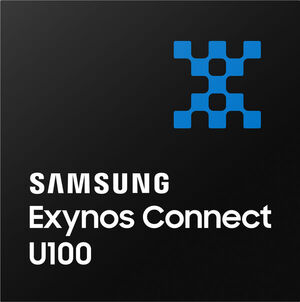
Samsung Announces Ultra-Wideband Chipset With Centimeter-Level Accuracy for Mobile and Automotive Devices
"Introduced under the newly launched ‘Exynos Connect’ brand, the Exynos Connect U100 offers highly precise distance measurement down to single-digit centimeters Samsung Electronics, a world leader in advanced semiconductor technology, today announced its first ultra-wideband (UWB) chipset, the Exynos Connect U100. With single-digit centimeter accuracy, the new UWB solution is optimized for use in mobile, automotive and Internet of Things (IoT) devices, offering precise distance and location information. Samsung also unveiled ‘Exynos Connect’, a new brand that consolidates its short-range wireless communication solutions, such as UWB, Bluetooth and Wi-Fi that are essential in facilitating an increasingly hyper-connected world. “Our Exynos Connect U100 combines sophisticated ranging and positioning capabilities with strong security to enable hyper-connectivity between people and everyday objects, fueling a range of new applications in positioning and location tracking,” said Joonsuk Kim, Executive Vice President of the Connectivity Development Team at Samsung Electronics. “Building on our technology leadership in communications technologies, we are committed to driving innovation in short-range communication solutions to transform the way we connect and relate to the world around us.” UWB is a short-range wireless communication technology that operates over a broad frequency spectrum, allowing for fast data transfers at low power. With its ability to capture highly accurate spatial and directional data, UWB is growing in popularity across various industries including those that deal with remote payments, smart keys, smart homes and smart factories." [...]

TI pioneers the industry's first stand-alone active EMI filter ICs, supporting high-density power supply designs
"Engineers can design smaller, lighter and more affordable solutions while optimizing system performance, efficiency and reliability Texas Instruments (TI) (Nasdaq: TXN) today debuted the industry’s first stand-alone active electromagnetic interference (EMI) filter integrated circuits (ICs), enabling engineers to implement smaller, lighter EMI filters, to enhance system functionality at reduced system cost while simultaneously meeting EMI regulatory standards. As electrical systems become increasingly dense and interconnected, mitigating EMI is a critical system design consideration for engineers. With innovative developments from Kilby Labs, TI’s research and development labs for new concepts and breakthrough ideas, the new portfolio of stand-alone active EMI filter ICs can sense and cancel common-mode EMI by as much as 30 dB at frequencies between 100 kHz and 3 MHz in single- and three-phase AC power systems. This capability enables designers to reduce the size of chokes by 50%, compared to purely passive filter solutions, and meet stringent EMI requirements. For more information on TI’s new power-supply filter ICs portfolio, see TI.com/AEF. "To meet customer needs for higher performance and lower-cost systems, TI continues to advance in power innovations to cost-effectively address EMI design challenges," said Carsten Oppitz, general manager for switching regulators at TI." [...]
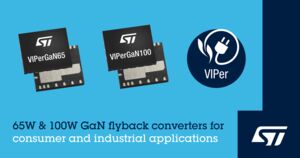
STMicroelectronics’ 100W and 65W VIPerGaN converters save space and raise efficiency in consumer and industrial applications
"STMicroelectronics has extended its high-voltage wide-bandgap power converter family by adding the VIPerGaN100 and VIPerGaN65 for single-switch quasi-resonant (QR) flyback converters up to 100W and 65W. The compact and highly integrated design targets switched-mode power supplies (SMPS) for USB-PD chargers, home appliances, smart-building controllers, lighting, air conditioning, smart metering, and other industrial applications. Each device integrates a pulse-width modulation (PWM) controller and a 650V enhancement-mode GaN power transistor and allows secondary-side regulation using a standard optocoupler. Housed in a 5mm x 6mm QFN package, the small footprint and advanced integration ensure superior power density and save bill-of-materials (BoM) costs. The wide-bandgap transistor technology enhances energy efficiency and simplifies thermal management. With advanced power management and low quiescent current, the converters consume standby power of less than 30mW operating in adaptive burst mode." [...]
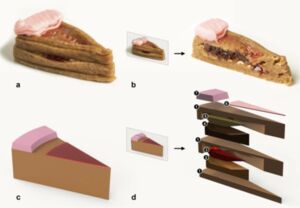
Scientists have made a seven-ingredient 3D printed cheesecake
"As 3D printing technology improves, people keep finding new uses for it. And the latest is pretty sweet: cheesecake. Researchers with the department of mechanical engineering at Columbia University created a seven-ingredient slice of cake using a 3D printer, and they say printing foods could be a new cooking option with several benefits. Printing food is not as avant-garde as it sounds. Such printers have been used to make organs before, and similar technologies already exist in the food space – like pizza and bread robots, pasta printers and automatic cake decorators, the researchers say in the study, published in the NPJ Science and Food journal. The researchers defined printed food as "the controlled deposition of an ingredient; as such, any ingredient that was extruded as a paste (e.g." [...]

Relativity Space’s first launch fails to reach orbit, but proves its 3D-printing rocket tech works
"Relativity Space achieved a massively important milestone just before 11:30 PM ET on Wednesday, with the first ever flight of its 3D-printed rocket technology. Its Terran 1 rocket took off from Cape Canaveral in Florida, successfully clearing the pad and launch structure, and achieving ‘Max Q’ – or the point during the launch sequence at which the vehicle is under the most pressure in terms of atmospheric resistance and stress – and also succeeded at cutting off its main engines and separating its first stage as intended. The launch did not reach orbit, which is an extremely rare thing to happen on a new space launch platform’s first ever flight anyway. Relativity said during the launch that they encountered an anomaly with the second stage engines after main engine cut-off and stage separation, which meant Terran 1 didn’t continue on its intended path to low-Earth orbit. This test launch did not include a payload or fairing, but instead carried a demonstration weight in the form of an early 3D-printed part from the company’s rocket development process. Relativity Space’s first launch should definitely be counted as a success, as the company proved that its 3D-printed rocket body can withstand the extreme forces at play during that crucial ‘Max Q’ period." [...]
Ciência e Tecnologia

Shining a light into the ‘‘black box’’ of AI
"An international team led by UNIGE, HUG and NUS has developed an innovative method for evaluating AI interpretability methods, with the aim of deciphering the basis of AI reasoning and possible biases. Researchers from the University of Geneva (UNIGE), the Geneva University Hospitals (HUG), and the National University of Singapore (NUS) have developed a novel method for evaluating the interpretability of artificial intelligence (AI) technologies, opening the door to greater transparency and trust in AI-driven diagnostic and predictive tools. The innovative approach sheds light on the opaque workings of so-called ‘‘black box’’ AI algorithms, helping users understand what influences the results produced by AI and whether the results can be trusted. This is especially important in situations that have significant impacts on the health and lives of people, such as using AI in medical applications. The research carries particular relevance in the context of the forthcoming European Union Artificial Intelligence Act which aims to regulate the development and use of AI within the EU. The findings have recently been published in the journal Nature Machine Intelligence." [...]

Verifying the security of electronic circuits
"Even though mathematically verifiable secure encryption algorithms do exist, in practice attackers manage to hijack data on a regular basis. This is because encryption doesn’t happen merely in theory. Secure electronic circuits are indispensable for transponder keys, card readers and smart-home technologies, to name but a few. But even cryptographic procedures that are one hundred per cent secure in theory are frequently compromised in practice – simply because fluctuations of the physical parameters of a chip, such as power consumption and temperature, can reveal sensitive data. In order to prevent these so-called side-channel attacks, researchers at Ruhr University Bochum are developing tools that can be used to verify the security of electronic circuits. They report on their findings in the Ruhr University’s science magazine Rubin." [...]

Ultra-lightweight multifunctional space skin created to withstand extreme conditions in space
"A new nano-barrier coating could help protect ultra-lightweight carbon composite materials from extreme conditions in space, according to a study from the University of Surrey and Airbus Defence and Space. The new functionality added to previously developed ‘space skin’ structures adds a layer of protection to help maintain space payloads while travelling in space, similar to having its very own robust ultralight protective jacket. The research team has shown that their innovative nano-barrier would help drastically increase the stability of carbon fibre materials, while reducing radiation damage. Professor Ravi Silva, corresponding author of the study and Director of the Advanced Technology Institute (ATI) at the University of Surrey, said: "Current aluminium shielding is not thermally stable or fully conformal, and therefore usually undesired for stable structures. Not to mention that aluminium shielding contributes to the mass and cost of satellites. Our nano-barrier addresses these issues and is a promising upgrade to the industry standard which could become a key accessory to all space and aircraft structures that are both mobile and static.” The coating is a highly dense superlattice structure applied to carbon fibre materials at room temperature which does not add over 1 μm of thickness, therefore keeping the materials lightweight." [...]

Sculpting quantum materials for the electronics of the future
"An international team led by the UNIGE has developed a quantum material in which the fabric of space inhabited by electrons can be curved on-demand. The development of new information and communication technologies poses new challenges to scientists and industry. Designing new quantum materials - whose exceptional properties stem from quantum physics - is the most promising way to meet these challenges. An international team led by the University of Geneva (UNIGE) and including researchers from the universities of Salerno, Utrecht and Delft, has designed a material in which the dynamics of electrons can be controlled by curving the fabric of space in which they evolve. These properties are of interest for next-generation electronic devices, including the optoelectronics of the future. These results can be found in the journal Nature Materials." [...]

Reduced speckle on the horizon
"A simple modification of a semiconductor laser's shape can improve the quality of its beam. An easy way of altering compact semiconductor lasers to make them more practical for illumination and holography has been demonstrated by KAUST scientists. Semiconductor technology allows for all elements of a laser to be packed into a micrometer-scale device. This includes an optically active, light amplification region with a highly reflective mirror on each side. One such device is the vertical-cavity surface emitting laser, or VCSEL. These are built by precisely placing, or growing, alternating layers of semiconductor on a substrate to create a highly reflective stack." [...]

Learning to grow machine-learning models
"New LiGO technique accelerates training of large machine-learning models, reducing the monetary and environmental cost of developing AI applications. It’s no secret that OpenAI’s ChatGPT has some incredible capabilities — for instance, the chatbot can write poetry that resembles Shakespearean sonnets or debug code for a computer program. These abilities are made possible by the massive machine-learning model that ChatGPT is built upon. Researchers have found that when these types of models become large enough, extraordinary capabilities emerge. But bigger models also require more time and money to train. The training process involves showing hundreds of billions of examples to a model." [...]
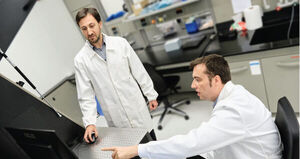
True randomness, by inkjet printer
"A microscale “memristor” with inkjet-printed electrodes offers an energy efficient and stable true random number generator for cryptography applications. Using an atomically thin flake of boron nitride and printed silver electrodes, a KAUST-led international team of researchers has made a breakthrough in miniaturizing one of the key components of modern cryptography devices — the true random number generator (TRNG). “TRNGs are important in data encryption where they are used to generate the keys to encrypt data before transmission by generating a stable stream of random numbers,” says KAUST’s Sebastian Pazos. “Current technologies integrate TRNGs into silicon chips in the form of large circuits that may require too much energy for some mobile applications.” Memristors are resistive elements whose resistance can be changed by applying different voltages. These have been investigated as potential TRNGs because of the intrinsic randomness of how the atoms rearrange internally when the resistance changes. Yet inter-device variability and poor endurance and stability of the randomness over time have been intractable issues, and they have yet to be integrated with conventional circuits." [...]

Robot Caterpillar Demonstrates New Approach to Locomotion for Soft Robotics
"Researchers at North Carolina State University have demonstrated a caterpillar-like soft robot that can move forward, backward and dip under narrow spaces. The caterpillar-bot’s movement is driven by a novel pattern of silver nanowires that use heat to control the way the robot bends, allowing users to steer the robot in either direction. “A caterpillar’s movement is controlled by local curvature of its body – its body curves differently when it pulls itself forward than it does when it pushes itself backward,” says Yong Zhu, corresponding author of a paper on the work and the Andrew A. Adams Distinguished Professor of Mechanical and Aerospace Engineering at NC State. “We’ve drawn inspiration from the caterpillar’s biomechanics to mimic that local curvature, and use nanowire heaters to control similar curvature and movement in the caterpillar-bot. “Engineering soft robots that can move in two different directions is a significant challenge in soft robotics,” Zhu says. “The embedded nanowire heaters allow us to control the movement of the robot in two ways." [...]

“Inkable” nanomaterial promises big benefits for bendable electronics
"An international team of scientists is developing an inkable nanomaterial that they say could one day become a spray-on electronic component for ultra-thin, lightweight and bendable displays and devices. The material, zinc oxide, could be incorporated into many components of future technologies including mobile phones and computers, thanks to its versatility and recent advances in nanotechnology, according to the team. RMIT University’s Associate Professor Enrico Della Gaspera and Dr Joel van Embden led a team of global experts to review production strategies, capabilities and potential applications of zinc oxide nanocrystals in the journal Chemical Reviews, a high-impact international journal. Professor Silvia Gross from the University of Padova in Italy and Associate Professor Kevin Kittilstved from the University of Massachusetts Amherst in the United States are co-authors. “Progress in nanotechnology has enabled us to greatly improve and adapt the properties and performances of zinc oxide by making it super small, and with well-defined features,” said Della Gaspera, from the School of Science. “Tiny and versatile particles of zinc oxide can now be prepared with exceptional control of their size, shape and chemical composition at the nanoscale,” said van Embden, also from the School of Science." [...]
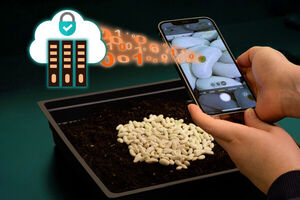
Tackling counterfeit seeds with “unclonable” labels
"Fake seeds can cost farmers more than two-thirds of expected crop yields and threaten food security. Trackable silk labels could help. Average crop yields in Africa are consistently far below those expected, and one significant reason is the prevalence of counterfeit seeds whose germination rates are far lower than those of the genuine ones. The World Bank estimates that as much as half of all seeds sold in some African countries are fake, which could help to account for crop production that is far below potential. There have been many attempts to prevent this counterfeiting through tracking labels, but none have proved effective; among other issues, such labels have been vulnerable to hacking because of the deterministic nature of their encoding systems. But now, a team of MIT researchers has come up with a kind of tiny, biodegradable tag that can be applied directly to the seeds themselves, and that provides a unique randomly created code that cannot be duplicated." [...]

By Cracking a Metal 3D-Printing Conundrum, Researchers Propel the Technology Toward Widespread Application
"Researchers have not yet gotten the additive manufacturing, or 3D printing, of metals down to a science completely. Gaps in our understanding of what happens within metal during the process have made results inconsistent. But a new breakthrough could grant an unprecedented level of mastery over metal 3D printing. Using two different particle accelerator facilities, researchers at the National Institute of Standards and Technology (NIST), KTH Royal Institute of Technology in Sweden and other institutions have peered into the internal structure of steel as it was melted and then solidified during 3D printing. The findings, published in Acta Materialia, unlock a computational tool for 3D-printing professionals, offering them a greater ability to predict and control the characteristics of printed parts, potentially improving the technology’s consistency and feasibility for large-scale manufacturing. A common approach for printing metal pieces involves essentially welding pools of powdered metal with lasers, layer by layer, into a desired shape." [...]

“Y-Ball” Compound Yields Quantum Secrets
"Rutgers physicists provide theoretical insights on experiment involving a “strange metal” that could be foundational to next-generation quantum technologies Scientists investigating a compound called “Y-ball” – which belongs to a mysterious class of “strange metals” viewed as centrally important to next-generation quantum materials – have found new ways to probe and understand its behavior. The results of the experiments, aided by the insights of theoretical physicists at Rutgers, could play a role in the development of revolutionary technologies and devices. “It’s likely that quantum materials will drive the next generation of technology and that strange metals will be part of that story,” said Piers Coleman, a Distinguished Professor at the Rutgers Center for Materials Theory in the Department of Physics and Astronomy at the Rutgers School of Arts and Sciences and one of the theoreticians involved in the study. “We know that strange metals like Y-ball exhibit properties that need to be understood to develop these future applications. We’re pretty sure that understanding this strange metal will give us new ideas and will help us design and discover new materials.” Reporting in the journal Science, an international team of researchers from Rutgers, the University of Hyogo and the University of Tokyo in Japan, the University of Cincinnati and Johns Hopkins University described details of electron motion that provide new insight into the unusual electrical properties of Y-ball. The material, technically known as the compound YbAlB4, contains the elements ytterbium, aluminum and boron." [...]

Stalactites and stalagmites in the battery?
"They are considered the "Holy Grail" of battery research: so-called "solid-state batteries". They no longer have a liquid core, as is the case with today's batteries, but consist of a solid material. This leads to several advantages: Among other things, these batteries are more difficult to ignite and can also be manufactured on a miniature scale. Scientists at the Max Planck Institute for Polymer Research have now turned their attention to the life cycle of such batteries and targeted processes that reduce it. With their findings, more durable solid-state batteries could be realized in the future. Whether in an e-car, cell phone, or cordless screwdriver, many devices used on a daily basis now use rechargeable batteries." [...]
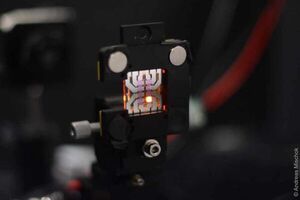
Displays with more brilliant colours through a fundamental physical concept
"A research team from the University of Cologne (Germany) and the University of St Andrews (Scotland) has shown in a new study how a fundamental physical concept can be used to boost the colour brilliance of smartphone, computer or TV screens without cutbacks in energy efficiency. The results have been published in Nature Photonics. Organic light-emitting diodes (OLEDs) have conquered the market for displays in recent years -- from high-resolution smartphone to wall-sized television screens. However, industry and science face several challenges in creating the next generation of devices with even higher colour saturation, brightness and efficiency. The organic molecules from which OLEDs are made have intrinsically broad emission spectra -- a property that limits the available colour space and saturation for high-end displays. Colour filters or optical resonators can be used to artificially narrow the emission spectra of OLEDs to circumvent this issue." [...]

Researchers create breakthrough spintronics manufacturing process that could revolutionize the electronics industry
"University of Minnesota Twin Cities researchers, along with a team at the National Institute of Standards and Technology (NIST), have developed a breakthrough process for making spintronic devices that has the potential to become the new industry standard for semiconductors chips that make up computers, smartphones, and many other electronics. The new process will allow for faster, more efficient spintronics devices that can be scaled down smaller than ever before. The researchers' paper is published in Advanced Functional Materials, a peer-reviewed, top-tier materials science journal. "We believe we've found a material and a device that will allow the semiconducting industry to move forward with more opportunities in spintronics that weren't there before for memory and computing applications," said Jian-Ping Wang, senior author of the paper and professor and Robert F. Hartmann Chair in the University of Minnesota Department of Electrical and Computer Engineering. "Spintronics is incredibly important for building microelectronics with new functionalities." Wang said Minnesota has been leading this effort in a big way for more than 10 years with strong support by the Semiconductor Research Corporation (SRC), Defense Advanced Research Projects Agency (DARPA), and the National Science Foundation (NSF)." [...]
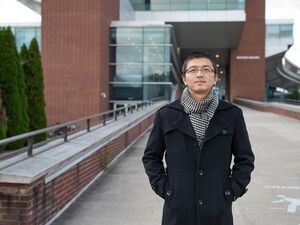
New soil sensor may improve efficiency of crop fertilization
"Measuring temperature and nitrogen levels in soil is important for agriculture systems but detecting them apart from one another is difficult to do. Huanyu “Larry” Cheng, James L. Henderson, Jr. Memorial Associate Professor of Engineering Science and Mechanics at Penn State, led researchers in the development of a multi-parameter sensor that can effectively decouple temperature and nitrogen signals so that each can be measured accurately. The results were recently published by Advanced Materials. “For efficient fertilization, there is a need for continuous and real-time monitoring of soil conditions, specifically nitrogen utilization and soil temperature,” Cheng said. “This is essential for evaluating crop health, reducing environmental pollution and promoting sustainable and precision agriculture.” Using nitrogen as a fertilizer is common practice in agriculture, and the goal is to use the ideal amount for the best crop output. When too little is nitrogen is used, the crop’s yield may be less than optimum." [...]
Semiconductor lattice marries electrons and magnetic moments
"A model system created by stacking a pair of monolayer semiconductors is giving physicists a simpler way to study confounding quantum behavior, from heavy fermions to exotic quantum phase transitions. The group’s paper, “Gate-Tunable Heavy Fermions in a Moiré Kondo Lattice,” published March 15 in Nature. The lead author is postdoctoral fellow Wenjin Zhao in the Kavli Institute at Cornell. The project was led by Kin Fai Mak, professor of physics in the College of Arts and Sciences, and Jie Shan, professor of applied and engineering physics in Cornell Engineering and in A&S, the paper’s co-senior authors. Both researchers are members of the Kavli Institute; they came to Cornell through the provost’s Nanoscale Science and Microsystems Engineering (NEXT Nano) initiative. The team set out to address what is known as the Kondo effect, named after Japanese theoretical physicist Jun Kondo." [...]

Surprise in the quantum world: Disorder leads to ferromagnetic topological insulator
"Magnetic topological insulators are an exotic class of materials that conduct electrons without any resistance at all and so are regarded as a promising breakthrough in materials science. Researchers from the Cluster of Excellence ct.qmat in Würzburg and Dresden have achieved a significant milestone in the pursuit of energy-efficient quantum technologies by designing the ferromagnetic topological insulator MnBi6Te10 from the manganese bismuth telluride family. The amazing thing about this quantum material is that its ferromagnetic properties only occur when some atoms swap places, introducing antisite disorder. The findings have been published in the journal Advanced Science. Harbingers of new technology In 2019, an international research team headed by materials chemist Anna Isaeva, at that time a junior professor at ct.qmat - Complexity and Topology in Quantum Matter, caused a stir by fabricating the world’s first antiferromagnetic topological insulator – manganese bismuth telluride (MnBi2Te4). This remarkable material has its own internal magnetic field, paving the way for new kinds of electronic components that can store information magnetically and transport it on the surface without any resistance." [...]

Batteries: Passivation Layer Mystery Solved
"In our daily lives, lithium-ion batteries have become indispensable. They function only because of a passivation layer that forms during their initial cycle. As researchers at Karlsruhe Institute of Technology (KIT) found out via simulations, this solid electrolyte interphase develops not directly at the electrode but aggregates in the solution. The scientists report on their study in the Advanced Energy Materials journal. Their findings allow the optimization of the performance and lifetime of future batteries. From smartphones to electric cars -- wherever a mobile energy source is required, it is almost always a lithium-ion battery that does the job." [...]

EPFL introduces minor in imaging to meet growing demand from research
"New imaging methods are being developed and adopted at a rapid pace in both research and industry. To equip EPFL graduates with the skills they’ll need, the School’s Center for Imaging is introducing a minor specifically in this area starting in the 2023–2024 school year. It’s the first program of its kind in Europe and will comprise an array of cross-disciplinary classes. Imaging systems generally work by analyzing the light and sound waves that an object either emits or propagates, in order to produce a view of the object. Today these systems have become an essential element of discovery in a number of fields, as they can collect and display information and phenomena invisible to the naked eye. While most people associate imaging with medical applications, it’s actually used in countless ways: to study exoplanets, observe proteins within cells, detect cracks inside materials, count wildlife populations, and perform optical inspections of production runs." [...]

Cracking The Concrete Code
"Concrete is the most used material in the construction industry and dates to the Roman Empire. Engineers at the University of Pittsburgh are now reimagining its design for the 21st century. New research introduces metamaterial concrete for the development of smart civil infrastructure systems. The paper, "Multifunctional Nanogenerator-Integrated Metamaterial Concrete Systems for Smart Civil Infrastructure," presents a new concept for lightweight and mechanically-tunable concrete systems that have integrated energy harvesting and sensing functionality. “Modern society has been using concrete in construction for hundreds of years, following its original creation by the ancient Romans,” said Amir Alavi, assistant professor of civil and environmental engineering at Pitt, who is the corresponding author on the study. “Massive use of concrete in our infrastructure projects implies the need for developing a new generation of concrete materials that are more economical and environmentally sustainable, yet offer advanced functionalities." [...]
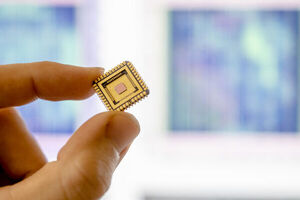
Detecting manipulations in microchips
"Attackers have the ability not only to manipulate software, but also to tamper with the hardware. A team from Bochum is devising methods to detect such tampering. Security gaps exist not only in software, but also directly in hardware. Attackers might deliberately have them built in in order to attack technical applications on a large scale. Researchers at Ruhr University Bochum, Germany, and the Max Planck Institute for Security and Privacy (MPI-SP) in Bochum are exploring methods of detecting such so-called hardware Trojans. They compared construction plans for chips with electron microscope images of real chips and had an algorithm search for differences." [...]

New microchip links two Nobel Prize-winning techniques
"Physicists at Delft University of Technology have built a new technology on a microchip by combining two Nobel Prize-winning techniques for the first time. This microchip could measure distances in materials at high precision, for example underwater or for medical imaging. Because the technology uses sound vibrations instead of light, it is useful for high-precision position measurements in opaque materials. The instrument could lead to new techniques to monitor the Earth's climate and human health. The work is now published in Nature Communications. Simple and low-power technology The microchip mainly consists of a thin ceramic sheet that is shaped like a trampoline." [...]

Doubling a qubit’s life, researchers prove a key theory of quantum physics
"Researchers at Yale have for the first time, using a process known as quantum error correction, substantially extended the lifetime of a quantum bit — a long-sought-after goal and one of the trickiest challenges in the field of quantum physics. Led by Yale’s Michael Devoret, the experiment proves — decades after its theoretical foundations were proposed — that quantum error correction works in practice. Quantum error correction is a process designed to keep quantum information intact for a period of time longer than if the same information were stored in hardware components without any correction. The results were published March 21 in Nature. Information in classical computing comes in the form of bits corresponding to ones or zeros. In quantum computing, information is stored in special devices with quantum properties that are known as quantum bits, or “qubits.” In the lab of Devoret, the Frederick W. Beinecke Professor of Applied Physics, these qubits are constructed with superconducting circuits cooled to temperatures 100 times lower than those in outer space." [...]

Robotic system offers hidden window into collective bee behavior
"EPFL researchers have developed a temperature-modulating robotic system that can be seamlessly integrated into notoriously sensitive honeybee hives, providing both a never-before-seen view of honeybee behavior and a means to influence it. Honeybees are famously finicky when it comes to being studied. Research instruments and conditions and even unfamiliar smells can disrupt a colony’s behavior. Now, a joint research team from the Mobile Robotic Systems Group in EPFL’s School of Engineering and School of Computer and Communication Sciences and the Hiveopolis project at Austria’s University of Graz have developed a robotic system that can be unobtrusively built into the frame of a standard honeybee hive. Composed of an array of thermal sensors and actuators, the system measures and modulates honeybee behavior through localized temperature variations. “Many rules of bee society – from collective and individual interactions to raising a healthy brood – are regulated by temperature, so we leveraged that for this study,” explains EPFL PhD student Rafael Barmak, first author on a paper on the system recently published in Science Robotics." [...]
Projetos Maker
Diversos Projetos interessantes.
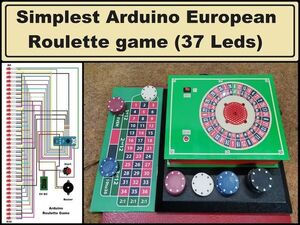
How to make simplest Arduino European Roulette Game
"Roulette is a casino game named after the French word meaning little wheel which was likely developed from the Italian game Biribi. In the game, a player may choose to place a bet on a single number, various groupings of numbers, the color red or black, whether the number is odd or even, or if the numbers are high (19–36) or low (1–18). To determine the winning number, a croupier spins a wheel in one direction, then spins a ball in the opposite direction around a tilted circular track running around the outer edge of the wheel. There are two popular roulette wheels: American and European. The European wheel has only one zero while the American wheel has two zeroes. Also the number sequence is different." [...]

Arduino-Based Handheld Simon Game
"Simon is a short-term memory game. The beautiful simplicity of the game makes it an entertaining pastime for all ages, as well as a commonly referenced example project in the fields of programming, electrical engineering, and product design. This project will combine several broad skills concepts that are common to makers. If you're worried your skills may not be up to par, fear not! I will break everything down as simply as possible while providing checkpoints along the way, as well as finished files, schematics, and code for those who are more interested in just making the game than learning the theory. As a little bit of lore, I programmed a software version of Simon for my 7th grade science fair project." [...]

ESP32 IOT based Home Automation Project
"Hello friends In this post we will learn how to make a ESP32 IOT based Home Automation project using Blynk 2.0. This days we here lots about IOT, IOT stands for Internet of things. In this project we build a system using ESP32 and internet so that we can control heavy loads of out home like, LIGHTS, FANS, AC, etc. I have used ESP32 board because obviously it have WIFI capability so we can connect it via internet and send command to turn load ON & OFF via Blynk IOT cloud. Also I have used ULN2003 IC it is array of seven NPN Darlington transistors, the output voltage level of digital pins of ESP32 is limited to 3V so it is not advisable to turn 5V relay ON through this pins. So here ULN2003 make our work easy, ESP give digital inputs to ULN2003 and ULN2003 turn on Relay respectively." [...]

TinyML under the hood: Spectral Analysis
"Introduction I have written several tutorials on Embedded Machine Learning projects in recent years. Among them, I explored a few devices capturing data from accelerometers such as Sensor DataLogger, TinyML Made Easy: Anomaly Detection & Motion Classification, TinyML Made Easy: Gesture Recognition, and TinyML - Motion Recognition Using Raspberry Pi Pico. What did all those projects have in common? Data come from accelerometers and Edge Impulse Studio, a leading development platform for edge-device machine learning. With the Studio, collecting time-series datasets and preprocessing them for input features on a Machine Learning model training was possible. Data preprocessing is a challenging area for embedded machine learning." [...]

How to Make Arduino Hollow Clock
"Hey Guys, in this video I will show you how I made this amazing hollow clock using Arduino in very easy way. Before starting let me tell you some basic information about hollow clocks, The Arduino Hollow Clock is a unique project that combines art and technology to create a mesmerizing and functional timepiece. This clock features a minimalist design, with a hollowed-out frame that reveals the inner workings of the clock. In this article, we'll look closer at the Arduino Hollow Clock, how it works, and how you can build one for yourself. What is the Arduino Hollow Clock? The Arduino Hollow Clock is a clock that is built using an Arduino board, 3D-printed parts, a stepper motor, and some other electronic components." [...]

Hello Houseplant
"A houseplant watering system that measures environmental data and allows for plant-human communication. Hello Houseplant is a smart plant watering system that collects environmental data and allows your houseplant to communicate with you about its need. Hello Houseplant collects environmental data including temperature, air quality, the amount of particulate in the air. These environmental factors are sent to the plant along with soil moisture readings to help determine its mood. The plant can then select from a list of words and phrases depending on its mood. The plant then uses an MP3 player and speaker to say positive things when its environment is ideal and alert you when conditions are not ideal." [...]

Automated pill dispenser
"Do you struggle to remember when to take your medication? If so, you need an automatic pill dispenser. If you're like me, you probably have trouble remembering to take your medication every day. Maybe you have a busy schedule, or maybe you just forget sometimes. Either way, it can be frustrating and even dangerous to miss your doses. I've always wanted some kind of a pill dispenser that would remind me when to take my pills and dispense them for me." [...]
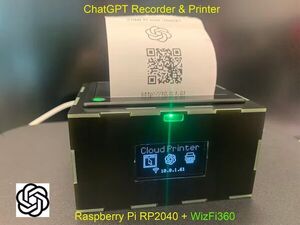
ChatGPT Recorder & printer (Cloud Printer)
"Print all the conversation process with ChatGPT and store it in the SD card ChatGPT, as the earliest OPEN AI program open to ordinary users, has been warmly welcomed by everyone since its launch, and currently has more than 100 million users. At present, ChatGPT also launched an API for users to use, and the information URL is as follows: Introduction - OpenAI API I use wizfi360 as http client to send ChatGPT API request and get ChatGPT Answer. WizFi360 is a WiFi module, which can connect to WiFi through commands and perform TCP or TCP (SSL) connections. I have used it many times and it is very convenient. RP2040 acts as an MCU, after get ChatGPT info from wizfi360, it performs data processing and print it out. " [...]

An Eye-Catching 3D Printed Hexagonal Cells LED Lamp
"LED lamps have always been popular DIY projects, and many creators are sharing their designs and lighting effects here on instructables or anywhere on the net. However I hope thisLED lamp project will stand out for its use of 3D printing components, some semi transparent hexagonal cells arranged in a circular pattern and very simple electronics and software. I chose to use hexagons as opposed to squares or circles as pixels, as they provide a more visually appealing and interesting pattern when arranged in a circular shape. The semitransparent nature of the cells also adds to the lamp's overall aesthetic appeal, allowing light to shine through and create a mesmerizing visual display. Also unlike other LED lamp projects that use bleeding to create lighting effects, this lamp emphasizes the clear separation of individual LED cells for a more visually appealing display of light. You can consider this lamp as a unique hybrid of several ideas, here on Instructables there are multiple examples including the LED Matrix Cylinder, the Ping Pong Ball LED Clock, and the HexMatrixClock." [...]

Attiny10 Chiptunes
"Chiptunes and simple musical games on a 36 cent chip. Some assembly required. You know those epoxy blob chips that play little chiptunes on musical greetings cards and dollar store childrens toys? Lets make those! Arguably, no one likes those things because they are annoying, but lets put that aside and ask another question what if we could use modern microcontrollers and sleep modes to make them work really efficiently so they can play for impressive periods of time? OK, maybe that just makes them annoying for longer but what if we could do it with a 36-cent microcontroller (attiny10) and very few external components, so we can reduce not just the energy cost of using the device, but also the energy that was invested in creating it, so you can pump out hundreds of them?" [...]

Visual CO2 Indoor Air Quality Sensor
"If the CO2 is high, the bird dies. Open a window to revive it. The problem We must take care of our health and in these times more than ever, considering the fact that we live in increasingly industrialized cities and affected by pollution, for this today's project, which I have called La Cigüita. Inspired by the use that miners gave to canaries in ancient times, for those who don't know, before all the sensors we have today existed, around 1800, miners explored the mines with a canary in a cage, if the canary suddenly showed signs of poisoning, the mine was evacuated, which meant that there were toxic gases in the area. What I will show you today is my version of a product called Canairi, it is a device that measures the level of CO2 in the air and if it is very high, it expresses it by making the canary turn downwards, inviting us to open the windows of the place. until the air clears, and we will know this when the canary is upright and happy again." [...]

Intelligent Notice Panel
"Update a notice panel message using Alexa voice control. ntroducing the project, "INTELLIGENT NOTICE PANEL WITH ALEXA". With this state-of-the-art technology, you can effortlessly control your display with the power of your voice. Whether you need to turn the display on or off or change the text to display precisely what you need, this system provides a hands-free solution to all your display needs.The beauty of this project lies in its simplicity. By utilizing the power of Alexa, you can seamlessly integrate your display into your smart home network and easily manage it with just a few simple voice commands. No more fumbling for remotes or struggling with confusing menus - with "Smarter Display using Alexa, " you can easily take control of your display." [...]
Secção Videos
Videos interessantes.
That's all Folks!








